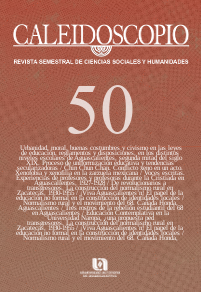5th Dimension Cartographies for the Practice of Psychosocial Action Research
DOI:
https://doi.org/10.33064/50crscsh7407Keywords:
action-research, 5th dimension, psychosocial intervention, qualitative methods, theoryAbstract
This text is an invitation to practice, a guide in the broadest sense of the word. 5th Dimension (5D) Cartographies is above all a tool, something we use to carry out different activities, research, intervention and even theoretical reflection. This is certainly not a formal definition and it is not because, following the logic of historical-cultural psychology, which supports the proposal, we will begin by defining it from its history. Later we will mention how it is articulated with other theoretical and methodological proposals in the humanities and social sciences to finally delimit what we understand and propose as 5D cartographies, thus, in the plural.
Downloads
References
Barragán-León, A. N. (2019). Cartografía social: lenguaje creativo para la investigación cualitativa. Sociedad y economía, (36), 139-159. https://www.redalyc.org/articulo.oa?id=99660272008 DOI: https://doi.org/10.25100/sye.v0i36.7457
Cano, L. Y. D., Medina, N. S., & Pichardo, A. A. H. (2019). La cartografía corporal, importancia en la educación para la salud. Aproximación a una revisión bibliográfica. Bio-grafía: escritos sobre la biología y su enseñanza, (extra 1), 590-602. https://dialnet.unirioja.es/servlet/articulo?codigo=7561537
Cong-Lem, N. (2022). Vygotsky’s, Leontiev’s and Engeström’s cultural-historical (activity) theories: Overview, clarifications and implications. Integrative Psychological and Behavioral Science, 56(4), 1091-1112. https://doi.org/10.1007/s12124-022-09703-6 DOI: https://doi.org/10.1007/s12124-022-09703-6
Crespo, I., Lalueza, J. L., Portell, M., & Sánchez, S. (2004). Aprendizaje Interinstitucional, Intercultural e Intergeneracional en una Comunidad Gitana. https://www.researchgate.net/publication/260684888_Aprendizaje_Interinstitucional_Intercultural_e_Intergeneracional_en_una_Comunidad_Gitana
Diez Tetamanti, J. M., & Chanampa, M. E. (2016). Perspectivas de la Cartografía Social, experiencias entre extensión, investigación e intervención social. Revista de Extensión Universitaria +E, (6), 84-94. https://www.redalyc.org/articulo.oa?id=564172835010 DOI: https://doi.org/10.14409/extension.v1i6.6316
Engeström, Y., & Sannino, A. (2017). Studies of expansive learning: Foundations, findings and future challenges. Educational Research Review, 5(1), 1-24. https://doi.org/10.1016/j.edurev.2009.12.002 DOI: https://doi.org/10.1016/j.edurev.2009.12.002
Jornet, A., & Cole, M. (2018). Introduction to symposium on Vygotsky and Spinoza. Mind, Culture, and Activity, 25(4), 340-345. https://doi.org/10.1080/10749039.2018.1538379 DOI: https://doi.org/10.1080/10749039.2018.1538379
Lalueza, J. L., Sánchez-Busqués, S., & Padrós, M. (2016). Creando vínculos entre Universidad y Comunidad: el proyecto Shere Rom, una experiencia de aprendizaje servicio en la Facultad de Psicología de la Universitat Autònoma de Barcelona. RIDAS. Revista Iberoamericana de Aprendizaje-Servicio, (2), 33-69. https://revistes.ub.edu/index.php/RIDAS/article/view/RIDAS2016.2.3
Leivas Vargas, Monique, Alejandra Boni Aristizábal, and Montse Mendoza Crespo. 2017. “Del Cuerpo a La Ciudad: Repensando Nuestros Territorios Desde La Investigación Colectiva Con Cartografía Social”. Kult-ur, 4(8),169-90. https://doi.org/10.6035/Kult-ur.2017.4.8.6. DOI: https://doi.org/10.6035/Kult-ur.2017.4.8.6
Mercado-Salas, R., Sousa, L., Palacios Montoya, J. C., & Sahagún Padilla, M. (2021). Let 's make a movie: an intergenerational activity with older people and adolescents in Aguascalientes, Mexico. Journal of Intergenerational Relationships, 19(3), 407-411. https://doi.org/10.1080/15350770.2020.1852994 DOI: https://doi.org/10.1080/15350770.2020.1852994
Michael, C. (1999). Psicología cultural. Morata.
Nilsson, M., & Nocon, H. (2005). School of Tomorrow: Teaching and Technology in Local and Global Communities. Peter Lang.
Palacios Montoya, J. C., Sahagún Padilla, M. Á., Reynaga Estrada, P., Colunga Rodríguez, C., & Lalueza Sazatornil, J. L. (2020). El cuidado de la salud desde una perspectiva histórico cultural: de la perspectiva a la práctica. En M. G. Luna y R. Delgado (Coords.) Investigación en Psicología: Nuevos desafíos para el siglo XXI (págs. 16-29). Porrúa.
Rey, J., & Granese, A. (2019). La cartografía como método de investigación en psicología. Psicología, Conocimiento y Sociedad, 9(1), 221-245. https://doi.org/10.26864/pcs.v9.n1.4 DOI: https://doi.org/10.26864/PCS.v9.n1.4
Roth, W. M., & Lee, Y. J. (2007). “Vygotsky’s neglected legacy”: Cultural-historical activity theory. Review of educational research, 77(2), 186-232. http://edcipr.com/wp-content/uploads/2017/02/Vygotsky-neglected-legacy.pdf DOI: https://doi.org/10.3102/0034654306298273
Roth, W. M. (2007). Emotion at work: A contribution to third-generation cultural-historical activity theory. Mind, culture, and activity, 14(1-2), 40-63. https://doi.org/10.1080/10749030701307705 DOI: https://doi.org/10.1080/10749030701307705
Sannino, A. (2015). The principle of double stimulation: A path to volitional action. Learning, culture and social interaction, 6, 1-15. https://doi.org/10.1016/j.lcsi.2015.01.001 DOI: https://doi.org/10.1016/j.lcsi.2015.01.001
Yamagata-Lynch, L. C. (2010). Activity systems analysis methods: Understanding complex learning environments. Springer. DOI: https://doi.org/10.1007/978-1-4419-6321-5
Downloads
Published
How to Cite
Issue
Section
License

This work is licensed under a Creative Commons Attribution-NonCommercial-ShareAlike 4.0 International License.
Licencia Creative Commons Atribución-NoComercial-CompartirIgual 4.0 Internacional
El lector es libre de compartir o adaptar el material en cualquier medio o formato bajo las condiciones siguientes: (a) debe reconocer adecuadamente la autoría, proporcionar un enlace a la licencia e indicar si se han realizado cambios; (b) no puede utilizar el material para una finalidad comercial y (c) si remezcla, transforma o crea a partir del material, deberá difundir sus contribuciones bajo la misma licencia que el original.
Resumen de la licencia
https://creativecommons.org/licenses/by-nc-sa/4.0/deed.es_ES
Texto completo de la licencia
https://creativecommons.org/licenses/by-nc-sa/4.0/legalcode
Cada autor es responsable del contenido de su artículo. En el caso de un texto colectivo, el primer autor asume la responsabilidad intelectual de los resultados del proceso editorial; los autores son responsables de obtener la licencia de autor para reproducir materiales gráficos o fotográficos que pertenecen a terceros.
Los autores asumen plena responsabilidad en el caso de falsificación de datos o falta de autenticidad en la investigación. Se comprometen, también, a no reutilizar trabajos ya publicados, total o parcialmente, para presentarlos en otra publicación.
Estas condiciones aplican tanto a la versión impresa como a la versión electrónica de la revista.


















